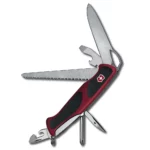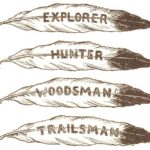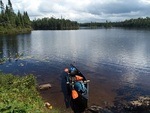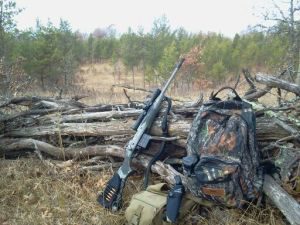
Thanks for checking out my Ruger Gunsite Scout Rifle review in .308 WIN. I had a lot of fun writing this post, and if you are looking to purchase this rifle you should get a fair amount of detail below pertaining to all aspects of the scout rifle concept as well the Ruger Gunsite Scout Rifle itself.
As I write this post I am in the middle of my fortieth year of life on this blue planet we call Earth. I’ve been hunting since the age of twelve. Longer than that if I count the forays into the woods that I did with my dad and uncles before I was able to carry a gun of my own to hunt with. I’ve owned several different firearms that could be used for various sizes of wild game, but mostly when it came to North American Big Game, such as black bear and white tailed deer, I have been using a Marlin lever action rifle, Model 1895 chambered in the venerable 45-70.
The recoil from a 300 grain hollow point bullet fired out of that Marlin would be considered punishing by many people, and a person shooting such a round would need to become stout towards such shoulder pounding recoil when firing multiple rounds at the gun range. But when it comes to big game, the 45-70 really packs a wallop, and offered a fairly flat trajectory out to 110 yards that truly knocks big game down.
I’ve used that model 1895 Marlin for the past eighteen years for all my big game hunting and it served me well. But this year in 2014 I am going to set aside my beautiful lever action in favor of a new gun I recently acquired; a Ruger Gunsite Scout Rifle.
Ruger Gunsite Scout Rifle Review – Scout Rifle Concept

What is a Ruger Gunsite Scout rifle? To answer that question we must first examine what a ‘scout rifle’is, or what it is characterized to be. People involved in the hobby of target shooting, hunting, and personal defense have probably heard of Colonel Jeff Cooper. Colonel Cooper graduated from Stanford University with a degree in political science and received a commission into the United States Marine Corps. He fought in World War Two and Korea.
In the mid 60s he got his masters degree in history from the University of California. He was the creator of what is known as the “modern technique” of handgun shooting (every time you see a law enforcement officer hold their handgun with both hands you can thank Cooper), he was one of the 20th century’s foremost experts on the use and history of small arms, was considered an expert in the field of big game hunting, had written several books, and founded the Gunsite Academy in 1976 in Arizona. He was also the man who came up with the concept of the “general purpose rifle”, which he dubbed as a scout rifle back in the early 80s.
Cooper’s concept for the scout rifle was based on this: If you could only have one rifle, and that rifle needed to do a great many things equally well as applied to hunting, tactical defense, offense, and survival, what would that rifle be? If you are a person who enjoys shooting, or hunting, or defense, or survivalism, or a combination of the four, ask yourself that question right now…If you could only have one rifle, and that rifle had to do a great many things equally well, what would that rifle be?
Cooper tried to define that concept with specific criteria that he commented on while teaching at Gunsite or wrote about over the years. Below are some of those criteria, and in reading them you will certainly notice that certain calibers and a types of rifle actions are weeded out.
- “The general-purpose rifle will do equally well for all but specialized hunting, as well as for fighting; thus it must be powerful enough to kill any living target of reasonable size. If you insist upon a definition of ‘reasonable size,’ let us introduce an arbitrary mass figure of about 1,000 lb (454 kg).” Col. Jeff Cooper ” The Art of the Rifle”
- “A general purpose rifle is a conveniently portable, individually operated firearm, capable of striking a single decisive blow, on a live target, at any distance at which the operator can shoot with the precision necessary to place a shot in a vital area of the target.” Col. Jeff Cooper “To Ride, Shoot Straight, and Speak the Truth”
- (a scout rifle) …should be superb for the individual sportsman or explorer faring far afield, and depending on the ‘one shot – one kill’ principle if it could be had in the neatest possible package.
- “The scout is a man trained in ground and cover, movement from cover to cover, rifle marksmanship, map reading, observation, and accurately reporting the results of his observation. If you replace ‘reporting’ with ‘acting upon,’ that’s a good definition of a hunter”. Col. Jeff Copper differentiating between a military scout and a scout hunter, of which he supported that his scout rifle concept could be used for both instances as needed.
- Weight-sighted and slung: 3 kilograms (6.6 lb). This has been set as the ideal weight but the maximum has been stated as being 3.5 kilograms (7.7 lb).
- Length: one meter (39 inches).
- Nominal barrel length: 0.48 meter (19 inches).
- Sighting system: Typically a forward and low mounted (ahead of the action) long eye relief scope of between 2x and 3x. Reserve iron sights desirable but not necessary. Iron sights of the ghost ring type, without a scope also qualify, as does a low powered conventional position scope.
- Action: Magazine fed bolt action for simplicity and reliability. Detachable box magazine and/or stripper clip charging is desirable but not necessary.
- Sling: Fast loop-up type, ie Ching or CW style to aid in offhand stabilized shooting.
- Caliber: Nominally .308 Winchester(7.62×51). Calibers such as 7mm-08 Remington(7x51mm) or .243 Winchester(6x51mm) being considered for frail individuals or where ‘military’ calibers are proscribed. Should be capable of being used to hunt most big game found in North America.
- Accuracy: should be capable of shooting into 2 minutes of angle or less (4″ at 200 yards/meters in 3 shot groups.
The above mentioned comments and specifications made by Cooper have been taken as gospel by many people, meaning that if a rifle falls anywhere outside those specifics than it is not a true scout rifle, but rather a pseudo-scout. I think that is narrow minded. Me, personally, I look at the information defined by Cooper as more of a set of guidelines, and there are a great many people who look at it the same way. After all, each person is different, and in terms of being a marksman some people need a gun that has a longer ‘length of pull’ (distance from butt-stock to the trigger) in order to shoulder and fire a rifle for proper target affect, which means extended stocks could put the gun outside the length mentioned above, or above the weight mentioned above. What may be a great scout rifle for me not be a great scout rifle for you. You need to take the guidelines and make them fit as best they can for you and your needs as a scout hunter.
Now that we have a better understanding of the scout rifle concept, lets take a look at the Ruger Gunsite Scout rifle.
Ruger Gunsite Scout Rifle (RGS)

Ruger Firearms designed the Ruger Gunsite Scout Rifle (RGS) in tandem with the insight and approval of Cooper’s Gunsite Academy, and it even carries the Gunsite name alongside Ruger’s. Check out the specs on the one I own, Model 6822:
- Barrel length: 18″
- Stock: black laminate
- Material/finish: matte stainless steel
- Rear site: adjustable
- Front site: post
- Length of pull: 12.75″ – 14.25″ (removable butt-stock spacers)
- Weight: 7.10 lbs
- Twist: 1:10 RH
- Capacity (as pictured with box magazine, 10)
- Length: 39.5″
- Caliber: .308 Win
- Forward picatinny rail system for long eye relief scope mounting
When I first came upon the RGS at the 2013 Shot Show in Las Vegas, it struck me that it looked similar to another gun that I had some history with, the Lee Enfield No. 5 Mk 1 Jungle Carbine. My father at one time had a collection of Lee Enfield rifles (they have since all been donated to the Wisconsin Veteran’s Museum In Madison, Wisconsin), but many years ago I had the opportunity to shoot the Jungle Carbine. I remember it as being a fun gun but had a slightly wandering zero. Looking at Cooper’s concept of the scout rifle it too fit most of the general criteria.

At the time I didn’t know much about the scout concept, I just remember the RGS I was looking at during the Shot Show seemed to be an interesting carbine that might be fun to shoot and hunt with. Later, after the Shot Show ended and I was back home I did a little research into the RGS and the ideals of what a scout rifle should be. I admit I was instantly intrigued and liked the thought of having a rifle that I knew could be used well for a great many things. So I saved money here and there, sold a few things I didn’t have a use for anymore and put that money aside, and eventually a good deal came along for a stainless steel RGS earlier in the year. Of course I just had to buy it.
My Ruger Gunsite Scout Rifle – Phase One, Iron Sights
I’ve spent over a year reading up on the scout rifle concept, and in particular I researched into what other owners of the RGS were doing with their rifles. I researched things like long eye relief scopes, various slings that were on the market, cheek pads, the various .308 Winchester loads, reloading, rifle accuracy, RGS hunting stories, what worked for other owners and what didn’t, and so many more things that listing them would be pointless – you get the idea.
Right out of the box the first thing I did was carefully read my owners manual while the gun sat before me on my work station rest. Then I cleaned it to remove all the factory remnants of cosmoline and checked to make sure all the ‘working parts’ were working. During that process I also removed the picatinny rail and reattached it using some medium grade lock-tite, as I had read online that other owners had the rail become loose from the vibrations of shooting, which in turn would throw off their scope shooting accuracy.
While I did already have a sling I purchased for my RGS, as well as a Leatherwood long eye relief scope and cheek pad, I did not attach any of those items to my rifle. I didn’t want to rush the experience of getting my scout rifle up and running. I had a check list I was following, and I wanted to take my time and follow through on it correctly, and that meant selecting a range load and going to the local Rod and Gun club to make sure the iron sights were dialed in. With a scope mounted the iron sights would not be usable, but all the same I wanted to ensure the irons on my RGS were going to be adjusted and accurate. After all, if something happened to my scope while in the field and it needed to be removed because it was not functional, I wanted to know that I could still use my gun with the iron sights.
In the research phase I heavily reviewed the ballistics for the .308 Winchester round as it applied to a shorter rifle barrel like that of my RGS (18″). As is well known by riflemen, the longer a rifle barrel is the more velocity the bullet has, giving the round long range characteristics with less bullet drop. Most high velocity rounds typically loose about 65-100fps for each inch loss in barrel length, but oddly enough that is not the case with the .308 round which looses on average only about 15-30fps for each inch of barrel loss under 24″. So my 18″ barrel on my RGS only loses about 150fps over what is considered ‘nominal’ barrel length by ammunition manufacturers as well as your typical long range hunters or sniper enthusiasts.
The nice thing about the .308 is that there are scores and scores and different weighted rounds that can be used for a variety of applications. For sighting in my iron sights I decided to go with PMC Bronze 147gr FMJ-BT (Full Metal Jacket, Boat-Tail). Not the most expensive round out there, but one that gets a lot of range use because it is affordable and gives a marksman a pretty good idea of where their gun is shooting and where they need to make adjustments to their iron sights. Also, this round was comparatively close in spec data to the rounds I would be using to sight in my scope and actually use for hunting, which are much, much more expensive (until I get around to making my own hand-loads).
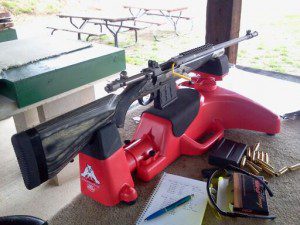
For me, I wanted my iron sights to be ‘zeroed’ in at two hundred yards. The reason for this has to do with my choice of scope I was going to put on my gun and the fact that it too would be zeroed at two hundred yards. It is easier to remember ballistic information when both iron sights and optics are zeroed for the same distance.
I ran some numbers through a ballistics calculator for PMC Bronze 147gr FMJ-BT and found for my barrel length shooting that particular round with a ballistic coefficient number of 0.398, with my iron sight about .7″ above the barrel, as well as some other figures I won’t bore you with, that sighting my gun in at fifty yards I would need to be impacting the target 1.9″ inches above the bulls-eye in order to be dead center of the bulls-eye at two hundred yards.
Here is the horizontal trajectory path for PMC Bronze 147gr FMJ-BT up to three hundred yards shot from my rifle using its iron sights based on specific load data I fed into a ballistic calculator:
- 25 yards: +0.8″
- 50 yards: +1.9″
- 100 yards: +3.0″
- 150 yards: +2.4″
- 200 yards: 0.0″
- 250 yards: -4.5″
- 300 yards: -11.1″
The 308 Winchester round is the preferred round used by U.S. Army snipers who claim the round’s effective range of 800 yards. The U.S. Marine snipers also favor the 308 but claim an effective range of 1000 yards. I doubt I would ever shoot at anything be it big game or a steel target at those ranges, but it is interesting to note.
Here is what it looks like on paper shooting at fifty yards using a bench rest:

The first three shots from the bench were low, but horizontally on. It was a simple matter to adjust the rear sight to get the gun sighted in where I wanted it. At two hundred yards it should be darn near its zero.
My Ruger Gunsite Scout Rifle – Phase Two, Optics
With the iron sights dialed in to where I wanted them to be, it was now time to move on to the optics. But I still was not rushing things and was planning on taking things slow. So that evening after I left the local gun range I went home and gave my rifle a light cleaning and set it aside for a few days. Over the course of those days I reviewed many times the processes for mounting an optic to a rifle. I had only done so a few times in the past, and I wanted to make sure I was going to be doing everything perfect on my Ruger Gunsite Scout Rifle. I checked my scope, my mounts, and the forward rail on the gun. I checked my tools I was going to use and made sure I even ran through a few mock setups preparing to do the work. I even went back and double checked and triple checked everything.
Then, after a few days, when it felt ‘right’ to do so, I sat down at my table with my rifle in its rest and the needed equipment to mount the scope.
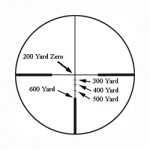
The scope I choose to mount on my RGS was the Leatherwood Hi-Lux 2-7x32mm Long Eye Relief scope with a BDC (bullet drop compensator) reticle. This scope was specifically designed for mounting to the Ruger Gunsite Scout Rifle and the BDC reticle was engineered for firing 308 Winchester rounds of 150gr to 165gr. The primary cross-hair is for zeroing at two hundred yards, and then each BDC line below that to the top of the bottom post accounts for one hundred yard increments. This scope was designed to aid the shooter for shots up to six hundred yards. I doubt I would shoot at any big game animal past two hundred yards, but I could certainly see myself having some fun with this rifle shooting at steel targets at those ranges.
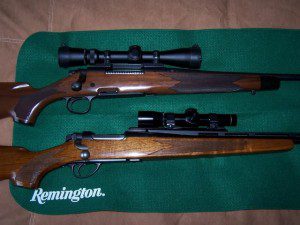
‘Eye Relief’ is the distance from your eye to the rear optic of the scope, and on most modern scopes that mount over the receiver of the gun the eye relief distance is typically 3-5 inches. So why a long eye relief scope? The scope I am mounting on my RGS mounts forward of the receiver, and has about twelve inches of eye relief. Since my use of scopes has been limited over the years, from what I have been reading about long eye relief scopes is that they are supposed to allow for a larger site picture, for much faster target acquisition, and can be used with both eyes wide open so you can keep track of what is going on around your target. I’ve done some practicing with my scope since mounting it, and I must admit that I am able to snap my rifle up and am sighted in on target instantly. And when needing to make snap shots, that is a very important ability to have. I have also practiced tracking moving targets with my scope, such as on squirrels, and have found that doing so with both eyes open while keeping the cross-hairs on target is almost effortless.
The rings I choose to use in mounting my scope were Leupold’s quick detach low mounts. They were a bit spendy, but I think well worth in. My decision to go with the quick detach mounts had to do with my lack of a solid history using optics on my firearms – I am not used to them, and if something went terribly wrong with my optics while in the field I wanted to be able to remove them and go back to the firearm’s iron sights as quickly as possible.
All of my prep work ahead of mounting the scope was worth it. Though it is not a difficult thing to mount a scope, it still took me about an hour before I was completely satisfied with my work. It took another ten minutes to bore sight the scope. I’ll not bore you with the step by step details of the mounting and bore sighting.
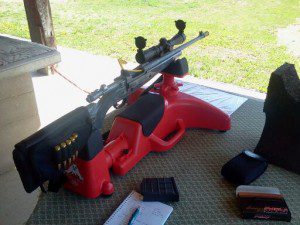
The next day I was back at the local Rod and Gun club to site in the scope. I started off shooting at a target only twenty-five yards away with the same PMC 147gr rounds I used to site in the iron sights. I was thrilled to find that my attempt at bore sighting in the scope proved successful, but I still needed to make some adjustments prior to shooting at the next stage of fifty yards. One click on my scope’s sight adjustments moves the internal optics 1/4 inch at one hundred yards, at fifty yards four clicks are needed for the same 1/4 inch adjustment, at twenty-five yards it takes eight clicks. After a few dozen clicks on the scope’s horizontal and elevation settings, a couple more follow up shots put me above the bulls-eye about half an inch. Good Enough to complete the initial twenty-five yard sighting in.
Fifty yards was a cake walk, I only spent a couple rounds making sure I was on the paper where I expected the bullets to hit, a little higher above the bulls-eye. I didn’t make any optic adjustments at fifty yards and moved on to one hundred yards instead. I didn’t want to waste any ammunition if I didn’t need to.
Before doing any shooting at the one-hundred yard range, I cleaned the barrel by running a bore-snake through it twice. Once that was done I switched ammunition over to Hornady’s American Whitetail 150gr soft point, which has near identical bullet trajectory to the PMC. The new round proved accurate, but I needed to make a few clicks on the scope to make sure future shots would place three inches high above the bulls-eye. After running four more shots through with the Hornady load I was pleased to see my RGS was shooting about one inch groups, slightly less actually, at one-hundred yards.
I wasn’t done quite yet though, I had another ammunition load I wanted to try out; Federal Fusion 165gr soft point, which was another hunting load. This round was also very close in ballistic trajectory to the previous other rounds, but actually had some better performance numbers out past three hundred yards, so I wanted to give it a try. Four shots from the bench, and yet again I was finding myself very pleased with my new gun, scope, and the rounds it was shooting. Three inches high at one hundred yards should put me on the bulls-eye at two hundred yards.
(Buy the Leatherwood Hi-LUX GSR Scope here)

Now that I know my gun shoots well from a bench rest, the hard part comes next, and that’s learning to shoot the thing as accurately as possible from a variety of field positions. I know the gun can shoot, and shoot well… and I need to be ready to use it for the 2014 Wisconsin deer season. Right now, when I handle the gun with the scope on it, it feels slightly strange to me, feels a little odd to move around. The reason is that I’m not used to handling a gun with a scope, it’s going to take some time and on hands practice to get comfortable with the firearm. I’m looking forward to it.
As Colonel Jeff Cooper used to say, “beware the man with only on rifle, for surely he knows how to use it.”
My Ruger Gunsite Scout Rifle – Phase Three, Practice Using It!

Phrase three of this project is learning how to use the thing proficiently out in the field, and will be an ongoing phase through the summer months and following fall.
So what I have is a scout rifle that can do a great many things equally well. It’s simple to operate and maintain in the field (can’t get much more simple than a bolt action). Fully loaded and decked out as seen above it weighs about 8.5lbs, and though I don’t ‘feel’ it yet, I’m sure once I get used to having a scope on this rifle it will be quite handy. It’s chambered in 308 Winchester and is suitable for North American Big Game hunting. It’s a well rounded hunting rifle for extended field work. As pictured above in addition to the scope and ring mounts I mentioned, it also has a butt-cheek unit attached that holds some extra rounds as well as a pocket that holds Allen-wrench tools for the rifle. The box magazine pictured is not the standard metal ten round that came with the gun, but rather a ten round polymer magazine to help reduce weight in the field. There is also an extended length sling attached. The bag that is pictured is my field bag I carry when hunting that keeps some basic items such as a field first-aid kit, matches, compass, emergency blanket, bone saw, spare skinning knife, extra ammunition, energy bars, and other goodies.
If interested in learning more about Colonel Jeff Cooper’s Scout Rifle Concept, I highly recommend you search Amazon for his book, The Art of the Rifle, it is very good, though a little costly unless you buy a used one. There is also a great website community that offers plenty of information about the scout rifle that can be found here: Scout Rifle Forums
All comments and questions welcome!



